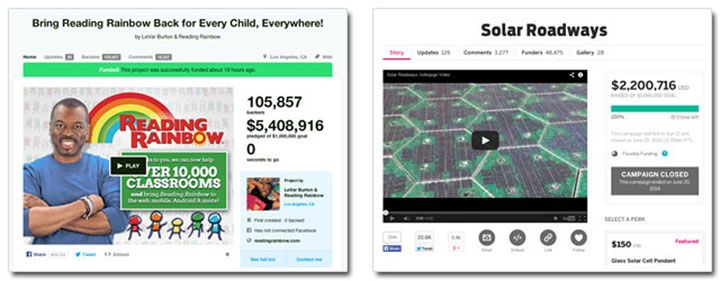
Two crowd-funding campaigns broke some records in the past few weeks.
On Kickstarter yesterday, LeVar Burton’s campaign to put Reading Rainbow back into production closed successfully. While it was the 5th most funded campaign on their site (with $5.4 million raised), it broke the record for the most amount of backers in a Kickstarter campaign. 105,857 pledged their support for Reading Rainbow.
Two weeks ago on Indiegogo, Solar Roadways closed out their campaign after extending it for an additional month due to a substantial amount of hype they received. By the close of their campaign, they had raised $2.2 million and broken Indiegogo’s record for the greatest number of funders with 48,475.
The most common donation to both campaigns was $50.
So what does this mean?
Well it could mean absolutely nothing.
Or, it could mean that we are becoming less and less resistant to making small donations toward an inspiring goal, donations that could accumulatively lead to giant steps forward.
These two campaigns in particular are good examples of not only successful campaigns but also of the types of crowd-funding efforts that are made through sites like Indiegogo and Kickstarter – the “Fund My Show” Campaign and the “Invest In The Future” Campaign.
“Fund My Show”
The majority of crowd-funding campaigns are of this type. I’m probably going to sound a little bit judgmental here – I’m not a fan of this type of campaign. They tend to just be about the donations. And what are the ultimate benefits? A Veronica Mars movie. A Zach Braff movie. A Spike Lee joint. Amongst a great deal of other content that often isn’t worth the budgets that were raised. Often, it’s like amateur filmmakers getting you to pay for their film school.
I was on a team that ran one of these types of campaigns a few years ago on Indiegogo. It was a successful $10K campaign in the end but we only received 3-4% of our donations through Indiegogo traffic. The other 96-97% of our donations were from people already in our network – our friends, family and peers. And upon successful completion of the campaign, Indiegogo took their 5% commission. In short, we could have pulled in another $100-200 from hosting the campaign on our own website with a Paypal donation button.
To me, that’s where this type of campaign belongs – on its own website. Anywhere else and it’s space-filler to me.
Reading Rainbow is an example of this type of campaign but it also has something else going for it…
“Invest in the Future”
This is the beating heart of crowd-sourcing. When you donate to this kind of campaign, it’s because you already have an emotional stake in the goals of a campaign. Or the goals are so fantastic that they can trigger your imagination to see the possibilities inherent in a successful outcome. Either way, something about these campaigns tugs at your heartstrings.
I donated $50 to Solar Roadways not because what the campaign proposed is possible – I’m not a mechanical engineer so I wouldn’t know one way or the other. I donated $50 because the idea itself was worth at least that much to me. The numerous possible outcomes of attempting to build solar receptors into road surfaces are inspiring to me. And even if the Solar Roadways team is only able to build a fraction of what they’re attempting, it’ll still be a step forward. And I can proudly say I helped at least one iota.
“Invest in the Future” crowd-funding campaigns speak to our common humanity. They identify a vacuum, something we’re missing, sometimes what we didn’t even know that we’re missing. Sometimes, they’re just about loose ends in our social structure that haven’t been tied off yet. Reading Rainbow ties off a loose end of child literacy. Solar Roadways reveals usabilities that we hadn’t considered.
“Invest in the Future” crowd-funding campaigns are less about the hard currency being raised than they are about the message we’re sending to each other when we support such a campaign. Even those who only share the campaign on social media are investing something in it. Whether you’re funding it or promoting it, you are putting your trust in an obvious common good. Even those who criticize a campaign for having impossible goals can see this common good – they just can’t see how it’s possible. It’s this authentic populism which brings thousands and thousands of small donations that alleviate the need for a single large donating body.
It’s self-government.
The Reading Rainbow campaign will lead to higher child literacy rates. The Solar Roadway campaign will lead to improvements in energy generation.
Because many of us declared it to be so. And then many of us put $50 where our mouths are.








